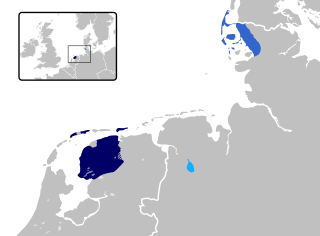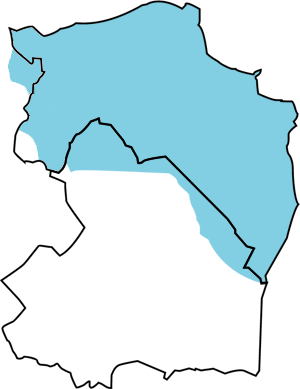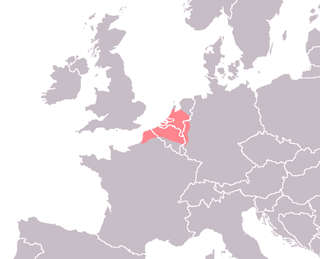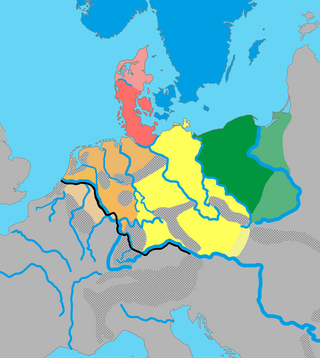
The Frisian languages are a closely related group of West Germanic languages, spoken by about 500,000 Frisian people, who live on the southern fringes of the North Sea in the Netherlands and Germany. The Frisian languages are the closest living language group to the Anglic languages; the two groups make up the Anglo-Frisian languages group and together with the Low German dialects these form the North Sea Germanic languages. However, modern English and Frisian are not mutually intelligible, nor are Frisian languages intelligible among themselves, owing to independent linguistic innovations and foreign influences.
The Frisians are an ethnic group indigenous to the coastal regions of the Netherlands, northwestern Germany and southern Denmark. They inhabit an area known as Frisia and are concentrated in the Dutch provinces of Friesland and Groningen and, in Germany, East Frisia and North Frisia. The name is probably derived from frisselje. The Frisian languages are spoken by more than 500,000 people; West Frisian is officially recognised in the Netherlands, and North Frisian and Saterland Frisian are recognised as regional languages in Germany.

Low Saxon, also known as West Low German are a group of Low German dialects spoken in parts of the Netherlands, northwestern Germany and southern Denmark. It is one of two dialect groups, the other being East Low German.

Frisia is a cross-border cultural region in Northwestern Europe. Stretching along the Wadden Sea, it encompasses the north of the Netherlands and parts of northwestern Germany. The region is traditionally inhabited by the Frisians, a West Germanic ethnic group.

In historical and comparative linguistics, Low Franconian is a linguistic category used to classify a number of historical and contemporary West Germanic varieties closely related to, and including, the Dutch language. Most dialects and languages included within this category are spoken in the Netherlands, northern Belgium (Flanders), in the Nord department of France, in western Germany, as well as in Suriname, South Africa and Namibia.

Low German is a West Germanic language spoken mainly in Northern Germany and the northeastern Netherlands. The dialect of Plautdietsch is also spoken in the Russian Mennonite diaspora worldwide.

West Frisian, or simply Frisian, is a West Germanic language spoken mostly in the province of Friesland in the north of the Netherlands, mostly by those of Frisian ancestry. It is the most widely spoken of the Frisian languages.

Limburgish, also called Limburgan, Limburgian, or Limburgic, is a West Germanic language spoken in Dutch Limburg, Belgian Limburg, and neighbouring regions of Germany.

Gronings, is a collective name for some Low Saxon dialects spoken in the province of Groningen and around the Groningen border in Drenthe and Friesland. Gronings and the strongly related varieties in East Frisia have a strong East Frisian influence and take a remarkable position within West Low German. The dialect is characterized by a typical accent and vocabulary, which differ strongly from the other Low Saxon dialects.

The Dutch are an ethnic group native to the Netherlands. They share a common ancestry and culture and speak the Dutch language. Dutch people and their descendants are found in migrant communities worldwide, notably in Aruba, Suriname, Guyana, Curaçao, Argentina, Brazil, Canada, Australia, South Africa, New Zealand and the United States. The Low Countries were situated around the border of France and the Holy Roman Empire, forming a part of their respective peripheries and the various territories of which they consisted had become virtually autonomous by the 13th century. Under the Habsburgs, the Netherlands were organised into a single administrative unit, and in the 16th and 17th centuries the Northern Netherlands gained independence from Spain as the Dutch Republic. The high degree of urbanisation characteristic of Dutch society was attained at a relatively early date. During the Republic the first series of large-scale Dutch migrations outside of Europe took place.

Hollandic or Hollandish is the most widely spoken dialect of the Dutch language. Hollandic is among the Central Dutch dialects. Other important language varieties of spoken Low Franconian languages are Brabantian, Flemish, Zeelandic, Limburgish and Surinamese Dutch.

The Anglo-Frisian languages are the Anglic and Frisian varieties of the West Germanic languages.

Franconian or Frankish is a collective term traditionally used by linguists to refer to many West Germanic languages, some of which are spoken in what formed the historical core area of Francia during the Early Middle Ages.

In linguistics, Old Dutch or Old Low Franconian is the set of dialects that evolved from Frankish) spoken in the Low Countries during the Early Middle Ages, from around the 6th or 9th to the 12th century. Old Dutch is mostly recorded on fragmentary relics, and words have been reconstructed from Middle Dutch and Old Dutch loanwords in French.

The predominant language of the Netherlands is Dutch, spoken and written by almost all people in the Netherlands. Dutch is also spoken and official in Aruba, Bonaire, Belgium, Curaçao, Saba, Sint Eustatius, Sint Maarten and Suriname. It is a West Germanic, Low Franconian language that originated in the Early Middle Ages and was standardised in the 16th century.
Dutch dialects are primarily the dialects that are both cognate with the Dutch language and spoken in the same language area as the Dutch standard language. They are remarkably diverse and are found within Europe mainly in the Netherlands and northern Belgium.

Dutch is a West Germanic language spoken by about 25 million people as a first language and 5 million as a second language. It is the third most widely spoken Germanic language, after its close relatives English and German. Afrikaans is a separate but somewhat mutually intelligible sister language of modern Dutch, and a daughter language of an earlier form of Dutch. It is spoken, to some degree, by at least 16 million people, mainly in South Africa and Namibia, evolving from the Cape Dutch dialects of Southern Africa. The dialects used in Belgium and in Suriname, meanwhile, are all guided by the Dutch Language Union.
Dutchification is the spread of the Dutch language, people or the culture of the Netherlands, either by force or cultural assimilation.

In historical linguistics, the Ingvaeonic nasal spirant law is a description of a phonological development that occurred in the Ingvaeonic dialects of the West Germanic languages. This includes Old English, Old Frisian, and Old Saxon, and to a lesser degree Old Dutch.
Central Dutch dialects are a group of dialects of the Dutch language from the Netherlands. They are spoken in Holland, Utrecht Province, south-western Gelderland, North Brabant and few parts of Limburg (Netherlands) and Friesland (Vlieland), and include Hollandic. It borders Low Saxon without Gronings, Limburgish, Brabantian and Zeelandic. Urkers, Frisian and Frisian mixed varieties are geographically close, too.

















